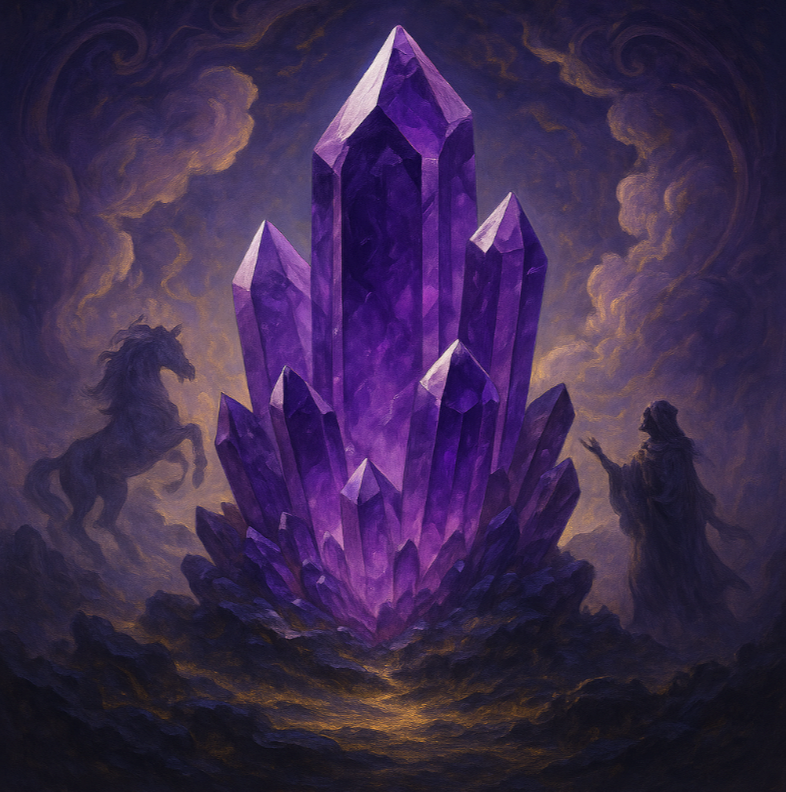
Purple Quartz: History, Symbolism & How It Inspires Us Today
Share
Purple quartz, also known as amethyst, is more than a beautiful violet stone. Its color, ranging from soft lilac to deep royal purple, is the result of trace amounts of iron and natural irradiation.
But beyond its geological identity, purple quartz carries a long and complex cultural legacy. From ancient mythologies to modern mindfulness trends, this crystal has evolved into a symbol that reflects both the rational and emotional sides of the human experience.
What Is Purple Quartz?
Scientifically classified as a variety of quartz (SiO2), purple quartz forms in geodes or cavities within volcanic rocks. Its distinctive hue is due to the presence of iron ions and their interactions with gamma radiation.
Major sources of high-quality purple quartz include Brazil, Uruguay, and Zambia. Today, both natural and lab-treated specimens are widely available, making it one of the most accessible and recognizable semi-precious stones in the world.
A Brief History of Purple Quartz Across Cultures
The Ancient World
In Greek mythology, the word "amethyst" comes from amethystos, meaning "not drunk." The Greeks believed purple quartz could prevent intoxication and carved drinking vessels from it. Romans, similarly, valued the stone for its rarity and aesthetic appeal. Ancient Egyptians used amethysts in jewelry and burial items, associating the stone with protection.
Medieval and Renaissance Europe
Purple quartz found its place in Christian iconography, symbolizing purity and spiritual focus. Bishops often wore amethyst rings, and Gothic cathedrals featured it in stained glass. Thinkers like Hildegard of Bingen wrote about the stone's moral and intellectual symbolism, and even early scientists continued to believe in its subtle effects on the mind and body.
From Alchemy to Enlightenment
During the Renaissance, alchemists attributed transformative powers to purple quartz, associating it with Saturn and deep contemplation. Later, in the Enlightenment era, scientists like Antoine Lavoisier analyzed its chemistry and debunked its mystical properties. Yet even as science demystified it, Romantic poets and naturalists re-enchanted the stone as a muse for creativity and beauty.
Modern Use: From Decoration to Emotional Anchoring
Today, purple quartz is popular in interior design, jewelry, and mindfulness accessories. While science explains its structure and formation, the stone's symbolic role continues to resonate. In the New Age and wellness communities, it is often associated with emotional balance, calmness, and spiritual clarity.

Rather than focusing on unverifiable claims, many contemporary creators are reframing purple quartz as an aesthetic and emotional anchor. Whether placed on a work desk, worn as jewelry, or featured in products like crystal bonsai trees, it becomes a symbol of intention, peace, and the search for meaning in a complex world.
The Psychology Behind Crystal Appeal
Studies in psychology and cultural anthropology suggest that humans have always ascribed meaning to natural objects as a way to process emotions and uncertainty. In today’s hyper-rational society, the tactile and symbolic presence of a stone like purple quartz can serve as a grounding ritual—a visual and physical reminder of beauty, reflection, and stillness.
Final Thoughts: Meaning and Matter Coexist
Purple quartz stands at the intersection of material science and cultural storytelling. It is a mineral with well-documented properties and a symbol shaped by thousands of years of human imagination.
Whether you view it as a geological marvel, a historical artifact, or a modern mindfulness tool, its enduring popularity is a testament to our deep need for symbols that bridge the gap between what we know and what we feel.
In a world increasingly defined by abstraction and speed, purple quartz reminds us of the quiet strength found in stillness—and the power of believing in beauty, however you define it.
X: ✍️ by Yanan
